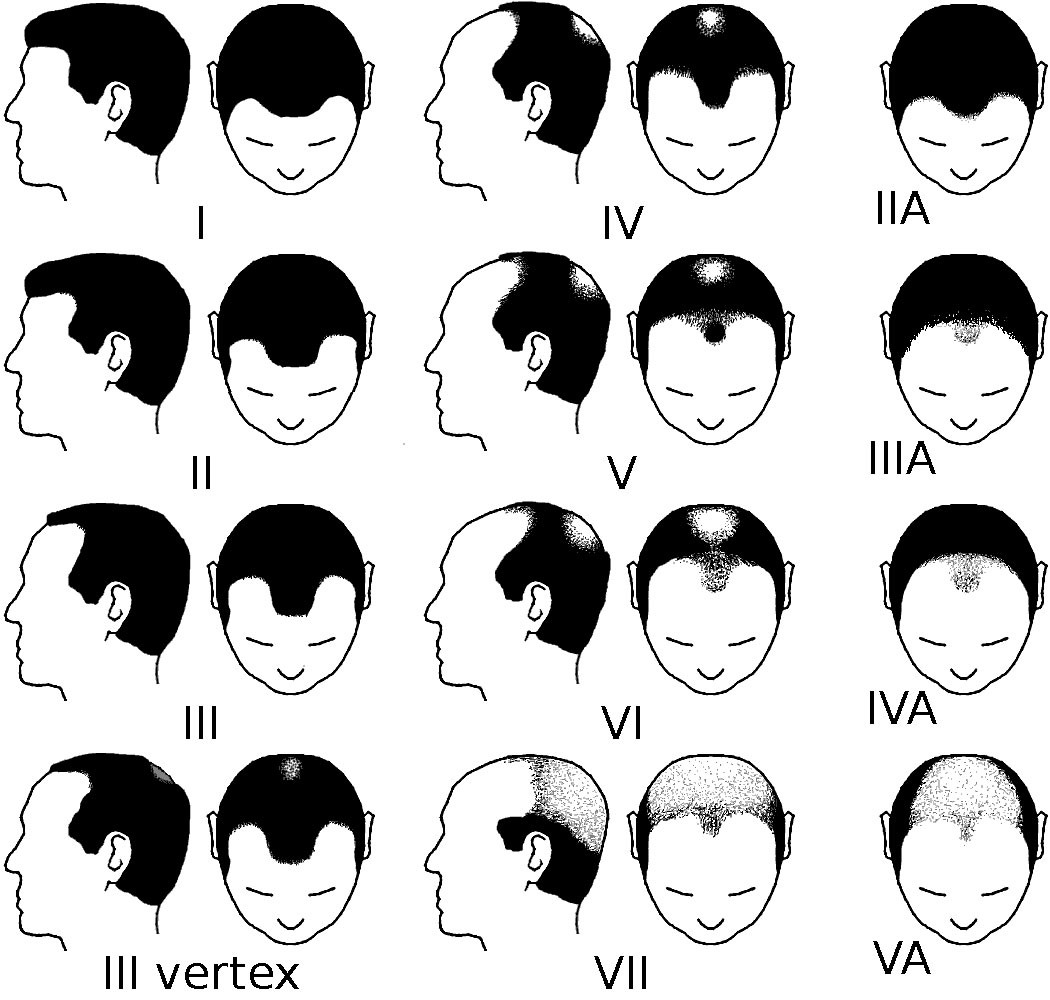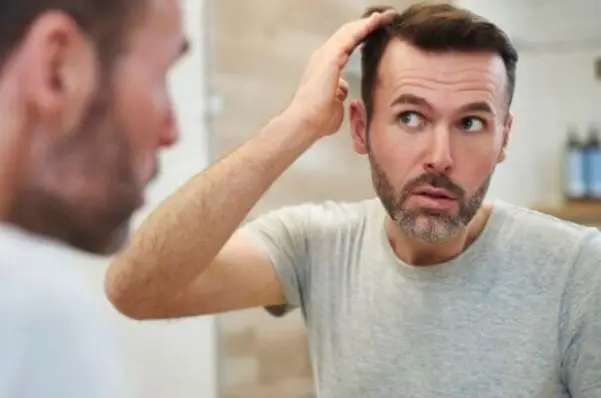Explore the intricate journey of Male Pattern Baldness Stages, from early signs to advanced stages of MPB. Understand your choices in managing MPB and learn about the various treatments available. Empower yourself with knowledge to make informed decisions about your hair health.
Male pattern baldness, also known as androgenetic alopecia, is a common type of hair loss that affects many men worldwide. This condition is characterized by a specific pattern of hair loss that progresses over time, typically starting with a receding hairline and gradually leading to more significant baldness. Understanding the stages of male pattern baldness can help you identify the condition early and seek appropriate treatment. This comprehensive guide will delve into the intricate details of male pattern baldness, exploring the 7 stages as defined by the Norwood-Hamilton scale.
By reading this article, you will gain a thorough understanding of each stage, its symptoms, causes, and potential treatment options. Whether you’re noticing hair loss or are in the later stages of baldness, this guide will provide valuable insights and practical advice. So, let’s embark on this journey to understand the stages of male pattern baldness and how to manage it effectively.
Understanding Male Pattern Baldness: An Overview
Male pattern baldness is a type of hair loss that occurs due to a combination of genetics and male sex hormones. It usually follows a pattern of receding hairline and hair thinning on the crown, and is caused by hormones and genetic predisposition.
Each strand of hair sits in a tiny hole (cavity) in the skin called a follicle. Generally, baldness occurs when the hair follicle shrinks over time, resulting in shorter and finer hair. Eventually, the follicle does not grow new hair. However, the follicles remain alive, suggesting that it is still possible to grow new hair.
The pattern of hair loss in male pattern baldness is distinct. The first sign is a receding hairline, which can start to recede at the temples and become an “M” shape. Over time, the hair at the top of the head also starts to thin, leading to a bald spot. Eventually, the two meet forming a U shape around the sides and back of the head.
The Norwood-Hamilton scale is a tool used to measure the extent and pattern of male pattern baldness. The scale identifies seven stages, each representing a different level of hair loss. Understanding these stages can help you identify where you are in the process and what to expect next.
For a more detailed look at the stages of male pattern baldness, check out our comprehensive guide on the Norwood Scale.
The Norwood-Hamilton Scale: Decoding the 7 Stages of Male Pattern Baldness

The Norwood-Hamilton scale is widely used to classify the stages of male pattern baldness. Here’s a breakdown of each stage:
- Stage 1: This is the control stage where there is no significant hair loss or receding hairline.
- Stage 2: Slight recession of the hairline around the temples occurs in this stage.
- Stage 3: This is the first stage that is considered significant balding, where the hairline becomes deeply recessed at both temples, resembling an “M”, “U”, or “V” shape. The recessed spots are completely bare or sparsely covered in hair.
- Stage 4: Hairline recession is more severe than in stage 2, and there is sparse hair or no hair on the vertex. The two areas of hair loss are separated by a band of hair that connects to the hair remaining on the sides of the scalp.
- Stage 5: The areas of hair loss are larger than in stage 4. They are still separated, but the band of hair between them is narrower and sparser.
- Stage 6: The balding area at the vertex and the hairline are joined together, and the band of hair across the crown is gone or sparse.
- Stage 7: The most severe stage of hair loss, only a band of hair going around the sides of the head remains. This hair is usually not dense and may be fine.
For a more visual representation of these stages, visit our detailed guide on the stages of balding.
Early Signs of Male Pattern Baldness
Recognizing the early signs of male pattern baldness can help you take proactive steps to manage the condition. Here are some signs to look out for:
- Receding Hairline: This is usually the first noticeable sign of male pattern baldness. You may notice that your hair is starting to recede at the temples, forming an “M” shape.
- Hair Thinning: You may notice that your hair is starting to thin, particularly at the crown of your head.
- Hair Loss on the Pillow or Shower: It’s normal to lose a few hair strands daily. However, if you’re noticing a significant amount of hair on your pillow when you wake up or in the shower, it could be a sign of male pattern baldness.
- Change in Hair Texture: Your hair may start to feel different. It may become finer, and you may have difficulty styling it as you used to.
If you’re noticing these signs, it’s important to consult with a healthcare provider or a dermatologist. They can provide a proper diagnosis and guide you on the best course of treatment. For more information on early signs and treatments, check out our guide on stage 1 hair loss treatment.
Male Pattern Baldness vs Female Pattern Hair Loss
While male pattern baldness is more common, women can also experience pattern hair loss, known as female pattern hair loss. The pattern of hair loss, however, is different. Women typically experience thinning hair all over the scalp, but mostly at the crown. They usually maintain their frontal hairline.
Both conditions are genetic and can be influenced by hormones. However, female pattern hair loss tends to occur later in life, typically after menopause.
For more information on how pattern hair loss affects both genders, check out our guide on male pattern baldness and female pattern hair loss.
Treatment Options for Male Pattern Baldness
While male pattern baldness is a permanent condition, several treatments can help slow down the hair loss process and improve hair growth. Here are some options:
- Medications: Drugs like minoxidil (Rogaine) and finasteride (Propecia) are commonly used to treat male pattern baldness. Minoxidil is a topical medication that you apply to your scalp, while finasteride is an oral medication.
- Hair Transplant Surgery: This involves transplanting hair follicles from areas of your scalp that have hair to the balding areas. It can be quite effective but is also more invasive and expensive.
- Laser Therapy: Low-level laser therapy can stimulate hair growth, though more research is needed to confirm its effectiveness.
- Natural Remedies: Some people find that natural remedies, such as scalp massage and essential oils, can help promote hair growth.
Remember, it’s important to consult with a healthcare provider before starting any treatment. They can help you understand the potential benefits and risks. For more information on treatments, check out our guide on stage 2 hair loss treatment.
The Impact of Male Pattern Baldness on Mental Health
Hair loss can have a significant impact on a person’s mental health. It can lead to issues with self-esteem and body image, and in some cases, can even lead to depression and anxiety. It’s important to seek support if you’re struggling with these feelings. Talking to a mental health professional or joining a support group can be very helpful.
FAQs About Male Pattern Baldness Stages
Here are some common questions people have about male pattern baldness:
At what age does male pattern baldness usually start?
Male pattern baldness can start at any age after puberty, but it’s most common in men in their 30s and 40s.
Is hair loss a sign of poor health?
Hair loss can be a normal part of aging, but it can also be a sign of certain health conditions. If you’re concerned about hair loss, it’s best to consult with a healthcare provider.
Can a change in diet slow down hair loss?
While a healthy diet can support overall hair health, it’s unlikely to slow down male pattern baldness, which is primarily caused by genetics and hormones.
What is Male Pattern Baldness?
Male pattern hair loss, or androgenetic alopecia, is the most common type of hair loss among males. The male sex hormone dihydrotestosterone (DHT) may play a key role in hair loss. Hair loss affects around half of all men over the age of 50 years, and around 50 million men in the United States.
How does Male Pattern Baldness start and progress?
Male pattern hair loss happens when the follicles slowly become miniaturized, the anagen phase is reduced, and the telogen phase becomes longer. The shortened growing phase means the hair cannot grow as long as before. Over time, the anagen phase becomes so short that the new hairs do not even peek through the surface of the skin. Telogen hair growth is less well-anchored to the scalp, making it easier to fall out.
What causes Male Pattern Baldness?
The exact reason why this happens is unknown, but genetic, hormonal, and environmental factors are all thought to play a role. DHT is believed to be a major factor. In men, the enzyme 5-alpha-reductase (5-AR) converts testosterone into DHT in the testes and the prostate. Up to 10 percent of testosterone is normally converted into DHT.
Can Male Pattern Baldness be reversed?
Finasteride, or Propecia, was approved for safety and efficacy in 1997, by the U.S. Food and Drug Administration (FDA). It is a selective inhibitor of type 2 5-AR. It is thought to act on the 5-AR enzyme that concentrates in the hair follicles to inhibit production of DHT. Studies of its efficacy have yielded apparently impressive results, but some people have questioned how effective it is.
What is the effect of Male Pattern Baldness on the body?
Male pattern hair loss can have a negative effect on the self-esteem of a man. To help relieve this, some treatments have already been developed.
For more detailed answers to these questions and more, check out our FAQ on How to Reverse Male Pattern Baldness Naturally.
The Future of Hair Loss Treatments
Research into hair loss treatments is ongoing, and the future looks promising. Scientists are exploring new treatments, such as stem cell therapy and gene therapy, which could potentially revolutionize the way we treat hair loss.
While these treatments are still in the early stages of research, they offer hope for those struggling with hair loss. For more information on the future of hair loss treatments, check out our guide on the future of hair loss treatments.
Stages of Mpb: Denial is Not a Solution
It’s not a pleasant thing to notice your hair thinning or perhaps no longer new hair growing in certain areas on your head, but denying what’s happening won’t do you any favors either.
A much better approach would be to find out what you can do to mitigate hair loss, and then seek the necessary treatment, medical advice, and lifestyle changes to give yourself an advantage over this very common issue. Use the information provided above to help you prevent or at least postpone the onset of male pattern baldness.
Conclusion
Understanding the stages of male pattern baldness is crucial in identifying the right treatment and managing expectations. It’s important to remember that hair loss is a natural part of aging for many men, and there’s no need to be embarrassed or ashamed.
While male pattern baldness can be an emotionally challenging condition to accept, there are numerous treatment options available today that can slow down the process or even help in hair regrowth. From topical treatments like Minoxidil to oral medications like Finasteride, and even surgical procedures like hair transplantation, there are many ways to tackle this issue.
However, it’s essential to consult with a healthcare professional or a dermatologist to understand the cause of your hair loss and choose the most effective treatment plan. Remember, early intervention is the key to managing and treating male pattern baldness effectively.
In the end, whether you choose to treat your hair loss or embrace it, remember that your worth is not defined by your hair. Confidence comes from within, and that’s what truly matters.
Key Takeaways: Understanding and Managing Male Pattern Baldness
Male pattern baldness is a common condition that many men experience. Understanding the stages of hair loss can help you identify the condition early and seek appropriate treatment. While male pattern baldness is a permanent condition, treatments can slow down the hair loss process and in some cases, stimulate new hair growth.
Remember, if you’re struggling with hair loss, you’re not alone. There are resources and treatments available that can help. Don’t hesitate to reach out to a healthcare provider if you have any concerns about hair loss.
References:
The following resources offer valuable insights into the stages of male pattern baldness:
- AI Powered Bald Filter Online 2024: See Yourself with No Hair! - January 19, 2024
- Harklinikken Bad Reviews 2024: Analyzing Negative Feedbacks - January 18, 2024
- How to Get the Alex Eubank Hair | Step-By-Step Tutorial 2024 - January 18, 2024








Too many people have no idea that scalp therapy shampoos for fast hair growth (obviously with no sulfates, no parabens, no DEA) are even a thing. People are now able to have longer hair and attain more options. Definitely worth looking up.
Whether you’re assessing alopecia, damaged hair, avoiding hair disorders, hair growth, hair and scalp health normally, almost the same rules become relevant.
In general, you want to stay away from hair treatments and products that include chemicals like parabens, DEA or sulfates.
What is healthy for your hair is healthy for your skin as well.
It goes without saying the content on this page is so useful for multiple reasons. It steers away from the usual errors and mistakes most fall into: purchasing defective alternatives. Thank you!
Good read!
Very helpful, would recommend:)
Great information thanks